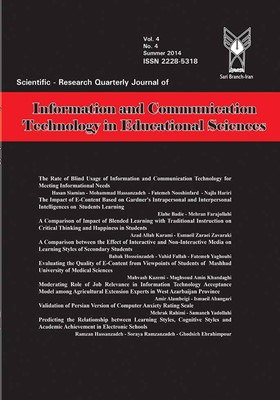پیشبینی روابط بین سبک های یادگیری، سبک های شناختی و پیشرفت تحصیلی در مدارس الکترونیکی
الموضوعات :
رمضان حسن زاده
1
![]() ,
ثریا رمضان زاده
2
,
قدسیه ابراهیم پور
3
,
ثریا رمضان زاده
2
,
قدسیه ابراهیم پور
3
1 - دانشیار گروه روانشناسی، دانشگاه آزاد اسلامی واحد ساری، ساری، ایران
2 - مدرس دانشگاه آزاد اسلامی واحد بندرگز، بندرگز، ایران
3 - مدرس دانشگاه آزاد اسلامی واحد بندرگز، بندرگز، ایران
الکلمات المفتاحية: پیشرفت تحصیلی, سبک های یادگیری, سبک های شناختی, مدارس الکترونیکی,
ملخص المقالة :
هدف پژوهش حاضر، پیشبینی روابط بین سبک های یادگیری، سبک های شناختی و پیشرفت تحصیلی در مدارس الکترونیکی می باشد. روش پژوهش، توصیفی از نوع همبستگی است. در پژوهش حاضر، ۱۵۰ دانشآموز پسر سال اول دبیرستان مشغول به تحصیل در مدارس الکترونیکی شهر تهران در سال 1392، از طریق نمونهگیری تصادفی خوشهای، به عنوان نمونه انتخاب شده و در پژوهش شرکت کردند. از پرسشنامه سبکهای یادگیری کلب، آزمون شکل های گروهی ویتکین و معدل پایان سال تحصیلی استفاده شد، تا چهار سبک یادگیری (همگرا، واگرا، جذبکننده و انطباقی) و دو سبک شناختی (وابسته به زمینه و مستقل از زمینه) و پیشرفت تحصیلی در آزمودنی ها اندازهگیری شود. داده ها با استفاده از رگرسیون گام به گام و ضریب همبستگی پیرسون مورد تحلیل قرار گرفت. یافته ها نشان داد که بین سبک های یادگیری و پیشرفت تحصیلی، و بین سبکهای شناختی و پیشرفت تحصیلی ارتباط معنیداری وجود دارد. همچنین، بیشترین سبک یادگیری در دانشآموزان، جذبکننده (3/51 درصد) و حداقل سبک ترجیح داده شده به عنوان سبک غالب انطباقیابنده (۶ درصد) بود. نتایج نشان داد، سبک های یادگیری و سبک های شناختی افراد می توانند به عنوان دو متغیر مهم شناختی در پیشرفت تحصیلی دانشآموزان نقش مهمی ایفا کند.


